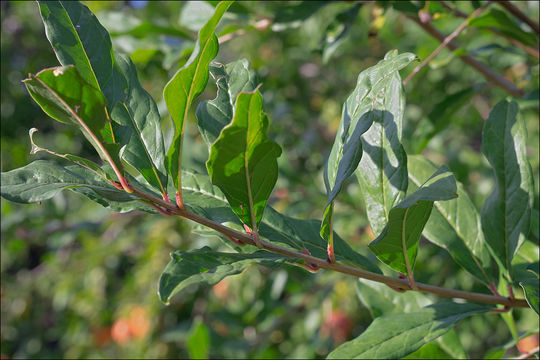Image of Pomegranate

Description:
Slo.: granatno jabolko - Habitat: Hedge of grassland among houses, slightly inclined hill slope, southeast aspect, dry place, full sun; skeletal ground; elevation 40 m (130 feet); average precipitations ~ 1000 mm/year, average temperature 12 - 14 deg C, Mediterranean phytogeographical region. Substratum: soil. - Comment: Punica granatum is a tall, often spiny shrub, sometimes a small tree. Its large vividly scarlet-red flowers as well as large (up to 8 cm in diameter, in cultivated plants often larger) orange-red fruits are very showy. Also its leaves are of beautiful color, copper-reddish when young, intensive green during the summer and yellow before they fall off early in winter. Fruits are edible, with many seeds and of an important commercial value. Punica granatum is mostly cultivated but naturalized almost in the whole Mediterranean and elsewhere today. On many places it also grows wild. Its origin is not completely clear. Eventually its native regions lay in Central Asia. The tree is one of the oldest known plants cultivated by men, known already about 5000 years ago. It is the most frequently mentioned in the Bible of all plants. Its uses are many; as a food, in horticulture, as medical plant, in the production of dyes and tannin, in heraldry, etc. A symbol of fertility! Ref.: (1) R. Brus, Drevesa in grmi Jadrana (Trees and bushes of Adria) (in Slovene), Modrijan Pub, (2012), p 318. (2) A. Martini et all., Mala Flora Slovenije (Flora of Slovenia - Key) (in Slovenian), Tehnina Zaloba Slovenije (2007), p 328. (3) M. Blamey, C. Grey-Wilson, Wild Flowers of the Mediterranean, A & C Black, London (2005), p 152. (4) I. Schnfelder, P. Schnfelder, Kosmos Atlas Mittelmeer- und Kanarenflora, Kosmos, (2002), p 132.
Included On The Following Pages:
- Life (creatures)
- Cellular (cellular organisms)
- Eukaryota (eukaryotes)
- Archaeplastida (plants)
- Chloroplastida (green plants)
- Spermatophytes (seed plants)
- Angiosperms (Dicotyledons)
- Eudicots
- Superrosids
- Rosids
- Myrtales (Myrtle Order)
- Lythraceae (loosestrife family)
- Punica (pomegranate)
- Punica granatum (Pomegranate)
This image is not featured in any collections.
Source Information
- license
- cc-by-nc-sa-3.0
- copyright
- 2017 Dr. Amadej Trnkoczy
- photographer
- Dr. Amadej Trnkoczy
- original
- original media file
- visit source
- partner site
- CalPhotos
- ID


